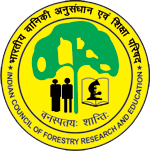Introduction:
The Institute of Forest Biodiversity was established during December 2012 vide ICFRE order no.58-21/XLVII/2012-ICFRE, dated 7th December 2012, by way of upgradation of the erstwhile Forest Research Centre, Hyderabad.
The Institute is located at Dulapally, which is 23 Km away from Secunderabad Railway station and 65 Km away from Rajiv Gandhi International Airport, Shamsabad. Spread over an area of one hundred acres, the Institute has the necessary infrastructure viz., administrative block, three laboratories (molecular genetics, tissue culture and soil science), library, field trial areas (comprising germplasm banks, seedling seed orchards, and agroforestry models), nursery area (complete with shade houses and mist chamber) to take up research and development projects on the biodiversity. The Institute has a field station spread over sixty acres at Mulugu, Hyderabad.
Mandate:
The Institute of Forest Biodiversity is created recently to carry out research on biodiversity of Andhra Pradesh, Maharashtra, with an emphasis on the forest biodiversity of Eastern Ghats.
Core Research Areas:
1- Quantitative ecological assessment and documentation of biodiversity of Eastern Ghats.
2- Genetic resource assessment of endemic and rare plants of Eastern Ghats for conservation planning.
3- Threat assessment for classification of Eastern Ghats biodiversity into rare, endangered and threatened species.
4- In situ conservation of the RET and endemic species of Eastern Ghats by identifying conservation populations/stands within the protected area networks.
5- Ex situ conservation of the RET and endemic species of Eastern Ghats by establishing germplasm banks, seed storage rooms and tissue culture rooms.
6- Utilization of Eastern Ghats biodiversity by applying the principles of genetic improvement and clonal propagation.
7- Utilization of Eastern Ghats biodiversity by the society by applying the principles of agro forestry.
8- Protection of Eastern Ghats biodiversity from the endemic and introduced insects and pathogens.
9- Effects of climate change on the biodiversity of Eastern Ghats and their mitigation.
10- EIA of mining and other mega projects on the Biodiversity of Eastern Ghats and their eco- rehabilitation.
Geographical Jurisdiction:
1- Eastern Ghats for Forest Biodiversity
2- Andhra Pradesh and Telangana
3- Forest Biodiversity aspects of Maharashtra and Goa
Key Achievements: (Click on link to view detail)
1- Biodiversity Assessment:
Surveyed and documented different plant communities of North coastal Andhra Pradesh capable of controlling soil erosion
The UNDP sponsored CBNRM project developed the forestry-based livelihood model in Jharkhand involving community participation in different natural and social scenarios with stupendous effort resulting in marked improvement of socio-economical condition of the rural people and conservation of natural resources. Under the project the institute also carried out the pioneering work on preparation of Peoples’ Biodiversity Registers.
Impact of podu cultivation on phytodiversity and soil factors in the Eastern Ghats of Andhra Pradesh was investigated and information on the species diversity and regeneration potential of forest tree species (saplings and seedlings) in areas cleared for podu cultivation documented.
Phytodiversity assessment was undertaken at 38 locations of Andhra Pradesh and Telengana, aimed at revision of forest types of India
Quantitative assessment of biodiversity was conducted in the dry Red sanders (Pterocarpus santalinus L. f.) bearing forest areas of Eastern Ghats, Andhra Pradesh
2- Forest Genetic Resource Assessment & Conservation:
1- Assessed Genetic Diversity and Structure in the natural populations of Pterocarpus santalinus using cpDNA markers.
2- Established a ‘Gene Conservation Stand’ of Pterocarpus santalinus containing 500 germplasm from 8 different populations.
3- Developed an improved field planting technique of Pterocarpus santalinus using coppicing technique.
4- Assessed mating system and gene flow within a clonal seed orchard of Tectona grandis using microsatellite markers.
5- Identified problems and generated recommendations for better management of Teak clonal seed orchards.
6- Protocol for in vitro propagation was standardized for Dalbergia latifolia
7- In Pterocarpus santalinus the multiple shoot initiation and multiplication of culture was standardized through explants and callus culture.
8- Assessment of Melia dubia and M. azedarach plus trees:
a) Melia dubia plus tree, PDT- 15 was superior in height and diameter followed by PDK-1 and PDA-24 (21.6 cm DBH and 7.1 m height).
b) Similarly in M. azedarach, PAK-6 exhibited maximum height and diameter followed by PAK-9 and PAK-3
9- Macro and micro propagation protocols were developed for M. dubia.
3- Agroforestry:
1- Several agroforestry models were tested in the semi-arid tropics of Telangana and Andhra Pradesh.
2- Eight different models found suitable for the region.
a) Technologies were extended to more than 3000 farmers.
b) Sandal, Red sanders and Melia dubia have been planted in over 10000 ha in both the states of A.P. and Telangana.
c) In one of the model predator-prey balance and significant higher yield of cotton could be achieved when cotton was grown as intercrop with ten other tree, bamboo and horticulture species
4- Integrated Pest Management:
1- IPM practices have been developed for important pests of Emblica officinalis e.g. Aonla aphid, Stem gall insect, and Bark eating caterpillar.
Ongoing Projects
Completed Projects
For more information visit: http://ifb.icfre.gov.in/



